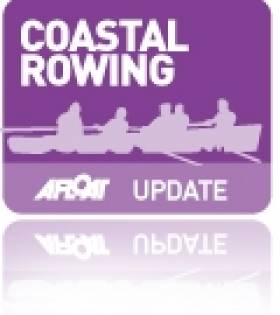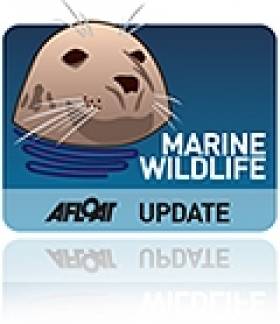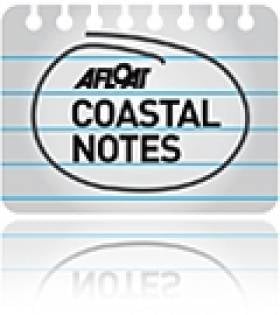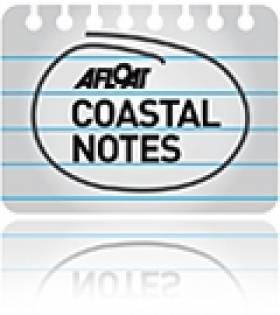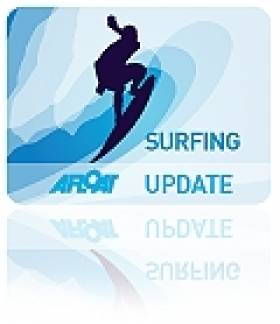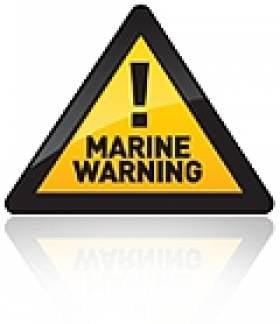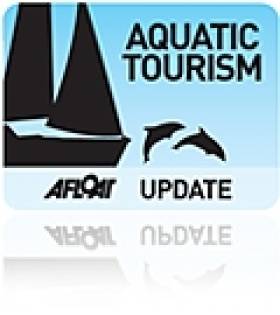Displaying items by tag: Kerry
Coastal Rowing Championships Promise Weekend of Action and Fun
#COASTAL ROWING: The All Ireland Coastal Rowing Championships will take place on Lough Currane, Waterville, Co Kerry, this weekend. About 2,700 rowers will descent on the picturesque village of Waterville, which lies on the Iveragh Peninsula, with 530 crews competing for a medal and a trophy. The action starts today (Friday) at 4pm.
The Kerry Coastal Rowing Association hosts the event. There are over 20 coastal rowing clubs, involved in organising the extensive programme of rowing and entertainment. There are a 25 categories of rowing, from the Under 12s to Master/Veteran.
Mary B Teahan, the PRO of the Irish Coastal Rowing Federation, said: “This regatta is the biggest regatta in the country and promises to be full of passion, pride and fantastic competition, where the best in the country will come to take on the might of each other. It’s a celebration of rowing. Crews from Donegal, Antrim, Belfast, Dublin, Wicklow, Wexford, Cork, and Kerry, will battle it out on the water and be assured of best of Kerry craic during the event. It’s also a showcase of what this part of the Iveragh Peninsula has to offer, in terms of tourism and promotion of the Wild Atlantic Way ... it ticks all the boxes.”
The event begins with a blessing of the boats, today at 4pm … Then the real rowing action begins.
Teahan said: “The opening ceremony promises to be a taste of Kerry. a lot of effort and time been put in to prepare for this prestigious event with the coastal rowing clubs, fund raising throughout the winter. The board has driven the preparations forward with the local rowing clubs and GAA in Waterville all helping out for the weekend. There is nightly entertainment in the green in the village with an array of bands and music and our nominated charity kindly stewarding.”
The event charity is Recovery Haven cancer services.
Forty heats will be rowed on Saturday. The finals take place on Sunday. The organisers say the atmosphere will be like Croke Park on All-Ireland final day: club colours worn with pride, club support out in force, the intense rivalry, the referee’s decision, the photo finish, the factions, club picnics, and maybe the old splash of rain!
The type of boat used in the Coastal Rowing Championships is called a ‘One Design’ – a fibre glass boat, fixed seat, a crew of four and cox. Another fine showcase to watch out for is The Seine boat crews of Mid and South Kerry where a 12-man crew, with a cox, races 18 kilometres.
Outdoors Guide & Instructor Training Courses in Kerry
#jobs – Why not become an outdoor instructor and guide? Spend your working days teaching kayaking, guiding on trails and mountains or introducing beginners to rock climbing.
Outdoors Ireland are running an intensive part-time Outdoor Instructor & Guide Training Course in Kerry, this October. Aimed at enthusiastic complete beginners; this course is designed to give the skills to produce a quality instructor and guide; employable in both the public and private sectors of outdoor education/adventure tourism.
This training course will also look at modules of setting up an adventure business, adding an adventure business onto an existing hospitality business, plus packaging adventure products, say Outdoors Ireland
Nathan Kingerlee, course director, says 'although it's not all as exciting and fun as it may seem from the outside, I really believe we have the best job in the world! Battling midges occasionally or washing mountains of wetsuits is easily offset by the privilege of working outdoors in spectacular untrodden areas.'
Outdoor education and adventure tourism has held strong through the past years of the bust and is now thriving as more and more people take to the hills, lakes and cliffs.
'It's can be hard to find exceptionally good instructors and guides, despite the number of training courses out there' says Kingerlee, 'I see this from the day to day running of Outdoors Ireland; so this course is about delivering brilliant and focused instructors, who are employable. More from Outdoors Ireland here.
#MarineWildlife - A humpback whale new to Irish waters has been confirmed by the Irish Whale and Dolphin Group (IWDG).
Photos of the humpback's fluke and dorsal fin captured by Nick Massett off Clogher and Sybil Heads in West Kerry at the weekend were examined by the IWDG's catalogue experts who have determined that the whale is a new arrival - and one with a fluke colouring that's rarely seen in Irish waters.
Details have since been sent to Allied Whale in the US state of Maine - which curates the North Atlantic humpback whale catalogue - to see if a match can be made among its database of more than 7,000 fluke images.
Meanwhile, Wildlife Extra reports that sailors in the Irish Sea are urged to keep a lookout for a large group of minke whales.
The group includes three juveniles and a calf previously spotted some 19 miles east of Ireland's Eye near Howth.
"Although sightings of Minke whale are to be expected in these waters, such a large group is a rare occurrence," said Danielle Gibas, sightings officer with the UK's Sea Watch Foundation, which is organising Britain's annual National Whale and Dolphin Watch this week till 3 August.
And in other cetacean news, scientists claim that dolphins call each other by name, calling back to the sound of their signature whistle but ignoring whistles that aren't theirs.
Herald.ie reports on the findings by marine scientists at the University of St Andrews, who studied a bottlenose dolphin group off the east coast of Scotland.
Using underwater speakers, they played synthesised versions of dolphin whistles they'd identified with particular dolphins to determine their reactions.
They were surprised to find that individuals called back after hearing their own 'name' but ignored others, whether they were for dolphins in the same group or strangers.
Minke Whales Putting On A Show Off West Cork and Kerry
#MarineWildlife - The Irish Whale and Dolphin Group is reporting a "high volume of sightings" of minke whales - plus the odd fin whale - off the coasts of West Cork and Kerry as this week's heatwave continues to bask the country.
The first reports from the early part of the week showed a big increase of sightings and activity in the southwest region - but also off Mullaghmore, the popular surfing spot in Co Sligo, where as many as three minkes were spotted last weekend, and as far afield as Belfast Lough where several minke whales were photographed.
As the week progressed, the first confirmed sighting of a fin whale came in from Slea Head in Co Kerry in waters teeming with six minke whales and around 150 common dolphins.
And a whale watch trip of West Cork came into range of an amazing 12 minke whales, including a number of juveniles who seemed to make a game of swimming around the watchers' vessel.
The latest reports came in on Thursday from Baltimore and Clougher Head, which indicate that fin whales may be arriving here in big numbers. Here's hoping a few humpbacks will follow in their wake!
Semisub Rig To Drill in Porcupine Basin
#Oil - The Blackford Dolphin semisubmersible drilling rig is expected to go to work off the south-west coast of Ireland next spring.
Offshore reports that Dolphin Drilling has negotiated the contract to appraise the Spanish Point prospect in the Porcupine Basin on behalf of Capricorn Ireland, subject to regulatory approval.
It will also drill early next year in British waters for MPX North Sea, with both contracts expected to last five months for a total revenue of €67 million.
The Porcupine Basin off Kerry has been identified as a source of enormous reserves of oil - after Petrel Resources announced the discovery of as much as one billion barrels of oil at the prospect late last year.
Road To Dingle Gets a Welcome Upgrade
#Dingle - The Minister for Transport, Tourism & Sport has officially opened a newly upgraded section of the main road to one of Ireland’s most popular coastal towns.
Minister Leo Varadkar opened the new section of the N86 road outside Annascaul which lies on the main route from Tralee to Dingle, and which is used by thousands of local residents and thousands more tourists every year.
The project cost around €9 million and was funded by the Department of Transport, Tourism & Sport. It was overseen by the National Roads Authority (NRA) and Kerry County Council and was completed in around 16 months.
Speaking at the launch, Minister Varadkar said: "This is an important project for West Kerry and the whole county, and will make a big difference to journeys in the area.
"But it has also national significance, as thousands of tourists travel along the N86 every year in order to reach Dingle, one of our premier tourism destinations."
He added: “Although the old N86 had its charms, it was also very narrow, and the stretch which we have upgraded had a number of dangerous junctions leading on to side roads. These have now been replaced and will make a big difference to safety levels.
"The new road is wider at 3 metres, and also provides a hard shoulder in each direction. I’m also very pleased that we have been able to offer cycle and pedestrian facilities along this stretch.”
In the longer term, the NRA plans to upgrade the entire length of the N86 between Dingle in the west of the peninsula, and Camp on the northern side.
The plan is to develop the 27km project as one of four Tourist Route Pilot Schemes, including cycle schemes and pedestrian access.
Similar schemes have already opened along the N59 near Clifden, Co Galway, the N59 at Kilbride, Co Mayo and the N56 at Glenties, Co. Donegal.
The proposal for the N86 would considerably improve safety levels and journey times in West Kerry, and improve road surfaces in the villages of Lispole, Annascaul and Camp on the Dingle Peninsula.
Surfing Film Unites Descendants of Blaskets King
#Surfing - The Blasket Islands are the setting for a new documentary following the exploits of two surfers descended from the ancestral 'king' of the island chain.
IrishCentral reports on The Crest, the story of two distant cousins from opposite sides of the United States - Andrew Jacob from Massachusetts and Dennis Kane from California. Though previously unknown to each other, the two nevertheless share a deep passion for surfing.
And it's the waves that bring them together as they unite in the land of their great-great-grandfather to indulge their obsession and ride the giant swells for which the west of Ireland is becoming so renowned.
Indeed, Canada's National Post is just the latest to discover the attractions of surfing at Lahinch and the Cliffs of Moher
Crowdfunded via a Kickstarter campaign, the documentary crew already shot footage in Cape Cod and San Diego before decamping to the Blaskets off Kerry last month to shadow the cousins as they connect to their roots.
The film is directed by Mark Corvino, who co-directed the current film festival favourite music documentary A Band Called Death.
Marine Notice: 3D Seismic Survey in Porcupine Basin
#MarineNotice - The latest Marine Notice from the Department of Transport, Tourism and Sport (DTTAS) advises of a 3D seismic survey in the Porcupine Basin off the Kerry coast to begin in early July for a period of seven weeks, weather permitting.
Polarcus, on behalf of Kosmos Energy Ireland, is scheduled to carry out the work over an area of more than 5,700 square kilometres in a region previously identified as having potential for enormous oil reserves.
Carrying out the survey will be the seismic vessel M/V Polarcus Amani (Call sign: C6ZD3). The vessel will be towing 10 cables, each 7.2km long and 150m apart, at a depth of 10m. The total width of the array is 1.35km. A buoy with a radar reflector and navigation strobe light will be deployed at the end of each cable.
The seismic vessel will also be accompanies by the support vessel M/V Bravo Sapphire (Call sign: ZDJY8) and chase vessel M/V Calvin (Call sign: 3EGU4). All three will be listening on VHF Channel 16 throughout the project.
The work vessels will also be restricted in their ability to manoeuvre while carrying out the survey, and all other vessel are requested to give these operations a wide berth and keep a sharp lookout in the relevant areas.
Full details of co-ordinates and a map of the work area are included in Marine Notice No 28 of 2013, a PDF of which is available to read or download HERE.
#Tourism - The world-class surfing hotspot of Sligo has failed to make the grade in Fáilte Ireland's long list of leading tourism towns for 2013, according to the Irish Independent.
The north-east county was among a surprise selection of areas known for their maritime and waterways attractions - such as Westmeath on the Shannon and Galway, host of last year's Volvo Ocean Race finale - that were not featured in the Irish tourism board's list of 45 towns and villages put forward for the Highly Commended Tourism Towns award, part of the National Tidy Towns Awards to be announced later in the year.
Counties on the water that did make the cut include Clare and Mayo, with five towns each on the list, Kerry with four - including last year's winner Portmagee - and Donegal and Waterford, represented three times each.
The top prize winner, to be announced by Fáilte Ireland in November, will receive €10,000 in supports for tourism marketing and development.
Though Sligo is conspicuous by its absence, Donegal's triple placing shows the north-east region is a big tourism attraction - and the Tripclocker blog says surfing is at the forefront of that.
With Ireland's exposure to the open Atlantic giving is "better waves more often", according to Killian O'Kelly of Bundoran's Turn n' Surf, there is a wide variety of surf beaches stretching from Donegal to Clare in particular with swells for all levels of experience.
#News - IrishCentral reports that a surfing instructor has been cleared over the death of an American tourist on a beach in Co Kerry two years ago.
Rowan Minjon of Castlegregory had pleaded not guilty to the charge of dangerous driving over the death of Kentucky woman Jenna Hill, who was struck by a reversing truck on Inch Beach in Ardroe on the morning of 2 July 2011 and suffered severe head injuries.
The trial at Tralee Circuit Court heard that the truck driven by Minjon - employed by the Offshore Surf School at the time - had no working horn nor reverse lights.
But Garda vehicle inspector Jim O'Brien said Minjon had not been aware of Hill's presence on the beach, and claimed that she should have noticed the "big bright noisy and near" truck as it approached.
IrishCentral has more on the story HERE.


























